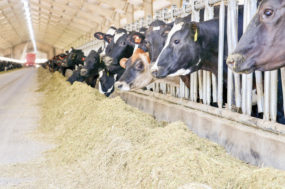Minnesota Milk recently held an online webinar on Sept. 25, 2018, titled, “How safe is your dairy farm? Protecting you and your workers.” In this webinar, key speakers Jeff Bender, co-director of the Upper Midwest Agricultural Safety and Health Center (UMASH), and Amy Liebman, director of environmental and occupational health at Migrant Clinicians, discussed what can be done to improve the safety on every dairy farm and the benefits that come from doing so.
1. Correct cattle handling
Bednar shared that, according to producers, the skill of the human handler is the most important factor in establishing good cattle flow. Numbers also suggest the quality of cattle flow can also play a role in safety.
Individuals who work in agriculture are eight times more likely to die on the job than any other occupation, with a 40 percent higher rate of nonfatal injuries. As well, those within the industry who are working with animals have a higher rate of injury. One-third of injuries on dairy farms are caused by interactions with cattle, proving that cattle flow is important to an operation’s safety.
Keep in mind that these percentages and numbers only come from incidents reported through workers’ compensation, meaning there are many injuries and illnesses not being recorded. This makes the statistics that we have the tip of the iceberg to a bigger picture.
One way to ensure safety and prevent those injuries and illnesses from happening is by making sure that proper training in animal handling is taking place by you and your employees. More specifically, low-stress cattle handling or stockmanship.
In simple terms, the purpose of this technique is to handle your cattle in a way that limits the stress on both them and you. This can be done by being aware of things such as your cows’ flight, depth perception and pressure zones. In addition, be aware of the cow’s blind spots and potential behaviors. The benefits of this handling method allow you to make sure your employees feel comfortable and safe around your cows, provide cows with quality care and increase milk production.
Below are links to the five short videos that UMASH has created to demonstrate these stockmanship principles and techniques, each being only a few minutes long.
- Using Predictable Animal Behavior to Increase Milk Production
- How a Cow Uses Her Senses
- Working with the Pressure Zone
- Moving Cows More Effectively
- Making the Milking Parlor a Happy Place
2. Education
Education is a key factor in safe farm operations for many reasons. One of those reasons being many dairy workers are immigrants who all have various educational backgrounds, which in turn leads to various understandings of health and safety practices. Immigrant labor accounts for 51 percent of all dairy labor, and 79 percent of the U.S. milk supply is produced by those dairies. This causes a language barrier – a barrier that, according to producers, is considered to be a serious challenge when it comes to worker training.
In order to fill this gap of worker training, Liebman and her team created the Bilingual Curriculum for Dairy Worker Safety Training. This curriculum consists of five different modules, each covering a different topic of health and safety.
Each one of these modules includes images and simple messages for a variety of scenarios to provide employees with educational information to keep them and the animals safe and healthy. These resources are available in both flip chart and PowerPoint form as well as online.
Some of the other resources provided include bilingual posters, all of which are described in both English and Spanish. The purpose of these modules and resources is to help educate all employees, regardless of their educational background, about the proper health and safety procedures necessary to maintain a safe operation. All of the curriculum can be found on the Migrant Clinicians Network website.
3. Continual communication
Finally, the above two steps can’t be effective without the last one: continual communication. Strive for constant and continual communication with employees about your dairy operation’s handling practices and expectations as well as constant and continual communication about your safety and health procedures. The best way to keep this communication ongoing is to establish a schedule. Make it a point to have monthly or weekly meetings with employees about the topic. Help them realize how important their safety and your animals’ safety is to you and the weight it carries on your farm.
In the words of Bender, the overall goal is to “create a culture of safety.” Now, that culture of safety looks different for everyone depending on their operation, but the communication needs to be regular. Ask your employees to be safe every day; make it a topic of conversation on a regular basis. These tactics and habits will make the above two steps effective, and they are crucial for seeing improvement in your operation.
The different methods listed above can be very effective for your operation if used individually, but using all three is the best way to ensure safety on your dairy farm because they work hand in hand. All of these methods, however, will require some change, time, consistency and effort, which are a small price to pay in comparison to the benefits of having a safe dairy farm where the employees and cattle are healthy, safe and above all, happy. ![]()
Ashley Hopkins is a senior at Utah State University in agriculture communications.





